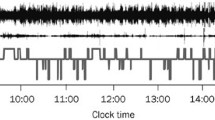Abstract
This study sought to evaluate the effect of classical music, using Mozart’s sonata for two pianos (K. 448), on changes in dopamine (DA) levels in the striatal nucleus (SN), prefrontal cortex (PFC) and mesencephalon, and on prolactin (PRL) and corticosterone secretion in adult male Wistar rats. Rats were divided into four groups: (1) control, (2) haloperidol treatment (single dose of 2 mg/kg s.c.), (3) music (two 2-h sessions per day) and (4) haloperidol plus music. Rats were sacrificed 2 h after haloperidol injection. Music prompted a fall in plasma PRL and corticosterone levels in healthy rats (P < 0.05) and prevented the increase in levels triggered by haloperidol (P < 0.001). Moreover, exposure to music was associated with a significant increase in DA levels in all groups, with the increase being particularly marked in PFC and SN (P < 0.001). Haloperidol is a recognised D2 receptor antagonist, and these findings suggest that music, by contrast, enhances DA activity and turnover in the brain. The results obtained here bear out reports that music triggers a reduction in systolic pressure and an increase in mesencephalon dopamine levels in human and rats treated with ecstasy, through a calmodulin-dependent system.
Similar content being viewed by others
References
Angelucci F, Ricci E, Padua L, Sabino A, Tonali PA (2007) Music exposure differentially alters the levels of brain-derived neurotrophic factor and nerve growth factor in the mouse hypothalamus. Neurosci Lett 429:152–155
Bishnoi M, Chopra K, Kulkarni SK (2009) Co-administration of nitric oxide (NO) donors prevents haloperidol-induced orofacial dyskinesia, oxidative damage and change in striatal dopamine levels. Pharmacol Biochem Behav 91:423–429
Boso M, Politi P, Barale F, Enzo E (2006) Neurophysiology and neurobiologic of the musical experience. Funct Neurol 21:187–191
Evers S, Suhr B (2000) Changes of the neurotransmitter serotonin but not of hormone during short time music perception. Eur Arch Psychiatry Clin Neurosci 250:144–147
Feduccia AA, Devauchelle CJ (2008) Auditory stimuli enhances MDMA-conditioned reward and MDMA-induced nucleus accumbens dopamine, serotonin and locomotor responses. Brain Res Bull 77:189–196
Fukui H, Toyoshima K (2008) Music facilitate the neurogenesis, regeneration and repair of neurons. Med Hypotheses 71:765–769
Givalois L, Naert G, Rage F, Ixart G, Arancibia S, Tapia-Arancibia L (2004) A single brain-derived neurotrophic factor injection modifies hypothalamo–pituitary–adrenocortical axis activity in adult male rats. Mol Cell Neurosci 27:280–295
Goebel S, Dietrich M, Jarry H, Wuttke W (1992) Indirect evidence to suggest that prolactin mediates the adrenal action of haloperidol to stimulate aldosterone and corticosterone secretion in rats. Endocrinol 130:914–919
Goldstein A (1980) Thrills in response to music and other stimuli. Physiol Psychol 8:126–129
Jausovec N, Jauosovec K, Gerlic I (2006) The influence of Mozart’s music on brain activity in the process of learning. Clin Neurophysiol 117:2703–2714
Kelley AE, Berridge KC (2002) The neuroscience of natural rewards: relevance to addictive drugs. J Neurosci 22:3306–3311
Kemper KJ, Danhauer SC (2005) Music as therapy. South Med J 98:282–288
Krumhansl CL (1997) An exploratory study of musical emotions and psychophysiology. Can J Exp Psychol 51:336–353
Lin LCh, Lee WT, Wu HCh, Tsai ChL, Wei RCh, Mok HK, Weng ChF, Lee MW, Yang RCh (2011) The long-term effect of listening to Mozart K.488 decreases epileptiform discharges in children with epilepsy. Epilepsy Behav (in press)
Liu Y, Wolfe SJJ (1996) Haloperidol and spiperone potentiate murine splenic B cell proliferation. Immunopharmacology 34:147–159
Lourenço GA, Dorce VA, Palermo-Neto J (2005) Haloperidol treatments increased macrophage activity in male and female rats: influence of corticosterone and prolactin serum levels. Eur Neuropsychopharmacol 15:271–277
Lu Y, Liu M, Shi S, Jiang H, Yang L, Liu X, Zhang Q, Pan F (2010) Effects of stress in early life on immune functions in rats with asthma and the effects of music therapy. J Asthma 47:526–531
Menon V, Levitin DJ (2005) The reward of music listening: response and physiological connectivity of the mesolimbic system. Neuroimage 28:175–184
Palermo-Neto J, de Oliveira MC, Robespierre de Souza W (2003) Effects of physical and psychological stressors on behavior, macrophage activity, and Ehrlich tumor growth. Brain Behav Immun 17:43–54
Pankseep J (1995) The emotional sources of “chills” induced by music. Music Perception 13:171–207
Polston JE, Rubbinaccio HY, Morra JT, Sell EM, Glick SD (2011) Music and methamphetamine: conditioned cue-induced increases in locomotor activity and dopamine release in rats. Pharmacol Biochem Behav 98:54–61
Ritsner M, Maayan R, Gibel A, Strous RD, Modai I, Weizman A (2004) Elevation of the cortisol/dehydroepiandrosterones ratio in schizophrenia patients. Eur Neuropsychopharmacol 14:267–273
Salimpoor VN, Benovoy M, Larcher K, Dagher A, Zatorre RJ (2011) Anatomically distinct release during anticipation an experience of peak emotion to music. Nat Neurosci 14:257–262
Scaccianoce S, Lombardo K, Nicolai R, Affricano D, Angelucci L (2000) Studies on the involvement of histamine in the hypothalamic–pituitary–adrenal axis activation induced by nerve growth factor. Life Sci 67:3143–3152
Sutou D, Akiyama K (2004) Music improves dopaminergic neurotransmission: demonstration based on the effect of music on blood pressure regulation. Brain Res 1016:255–262
Author information
Authors and Affiliations
Corresponding author
Additional information
Inmaculada Tasset and Ismael Quero contributed equally to this paper.
Rights and permissions
About this article
Cite this article
Tasset, I., Quero, I., García-Mayórgaz, Á.D. et al. Changes caused by haloperidol are blocked by music in Wistar rat. J Physiol Biochem 68, 175–179 (2012). https://doi.org/10.1007/s13105-011-0129-8
Received:
Accepted:
Published:
Issue Date:
DOI: https://doi.org/10.1007/s13105-011-0129-8




